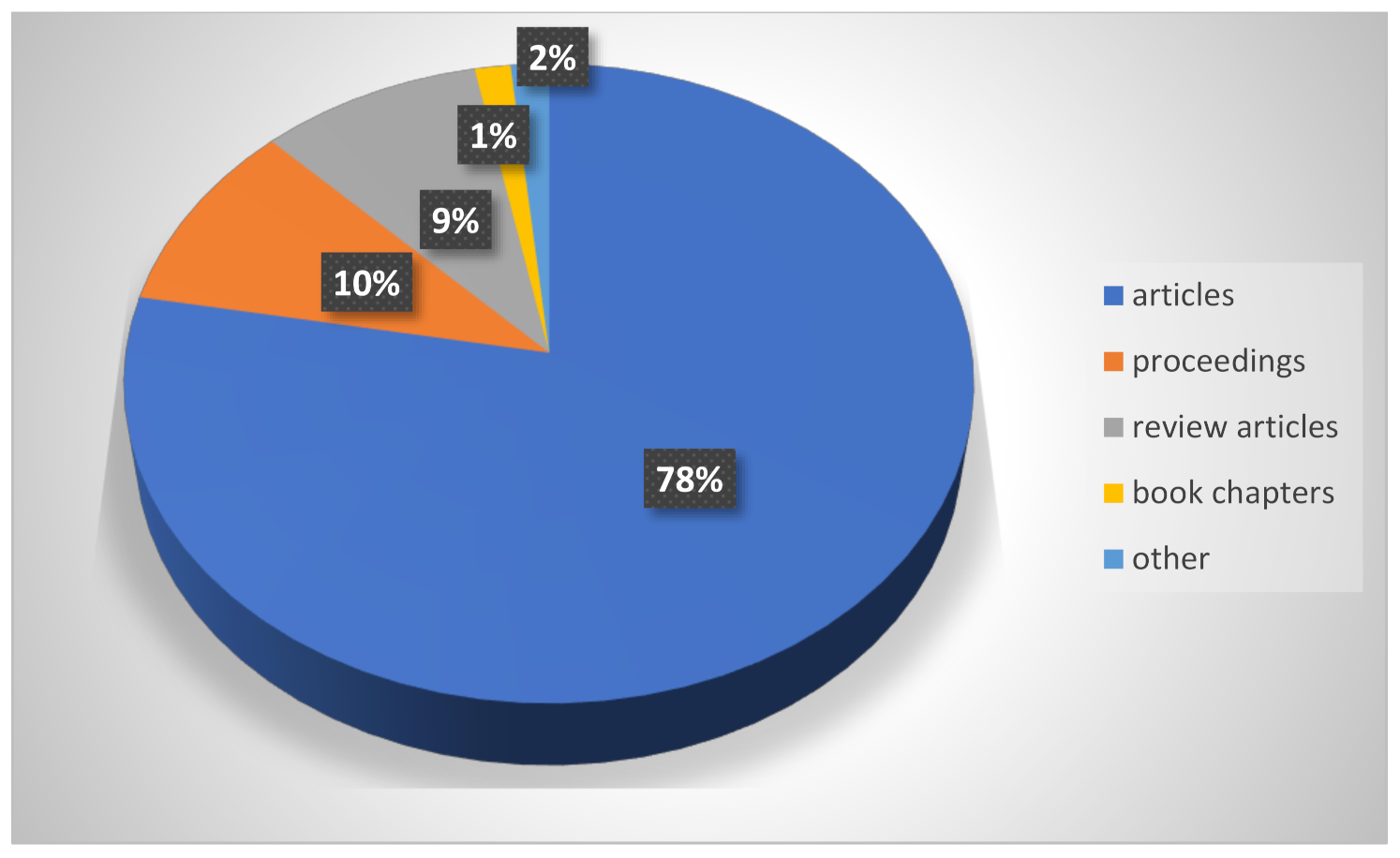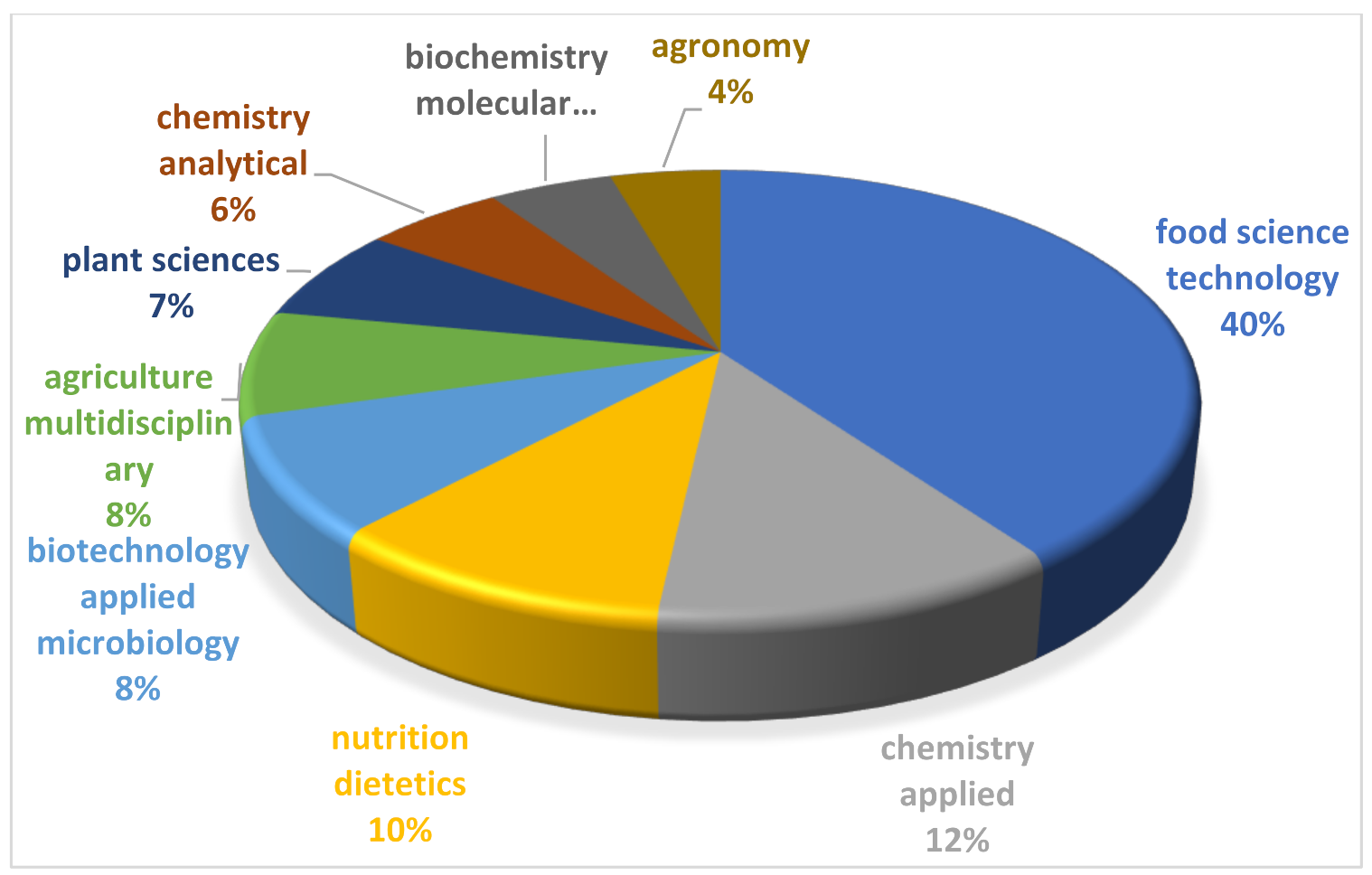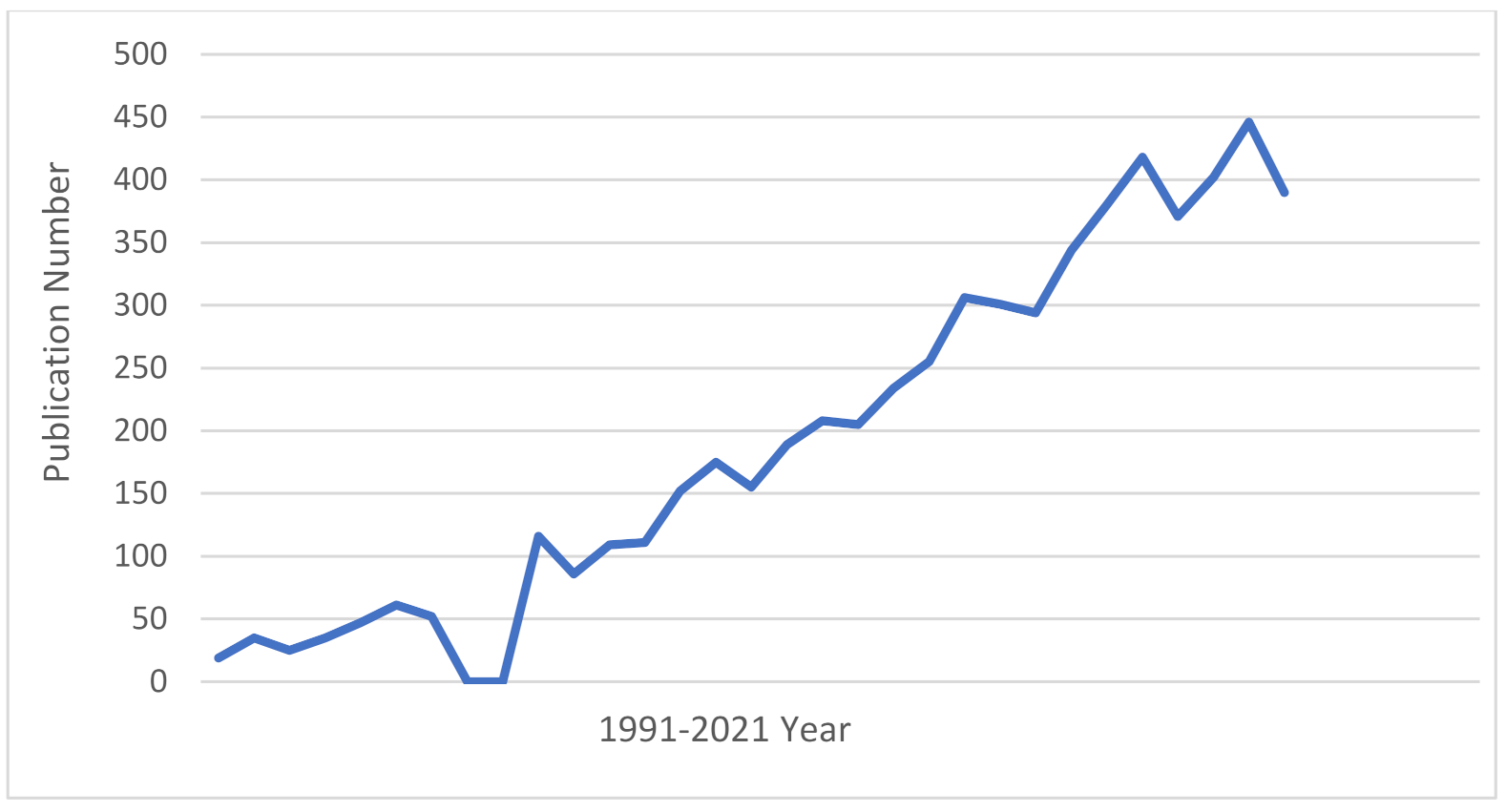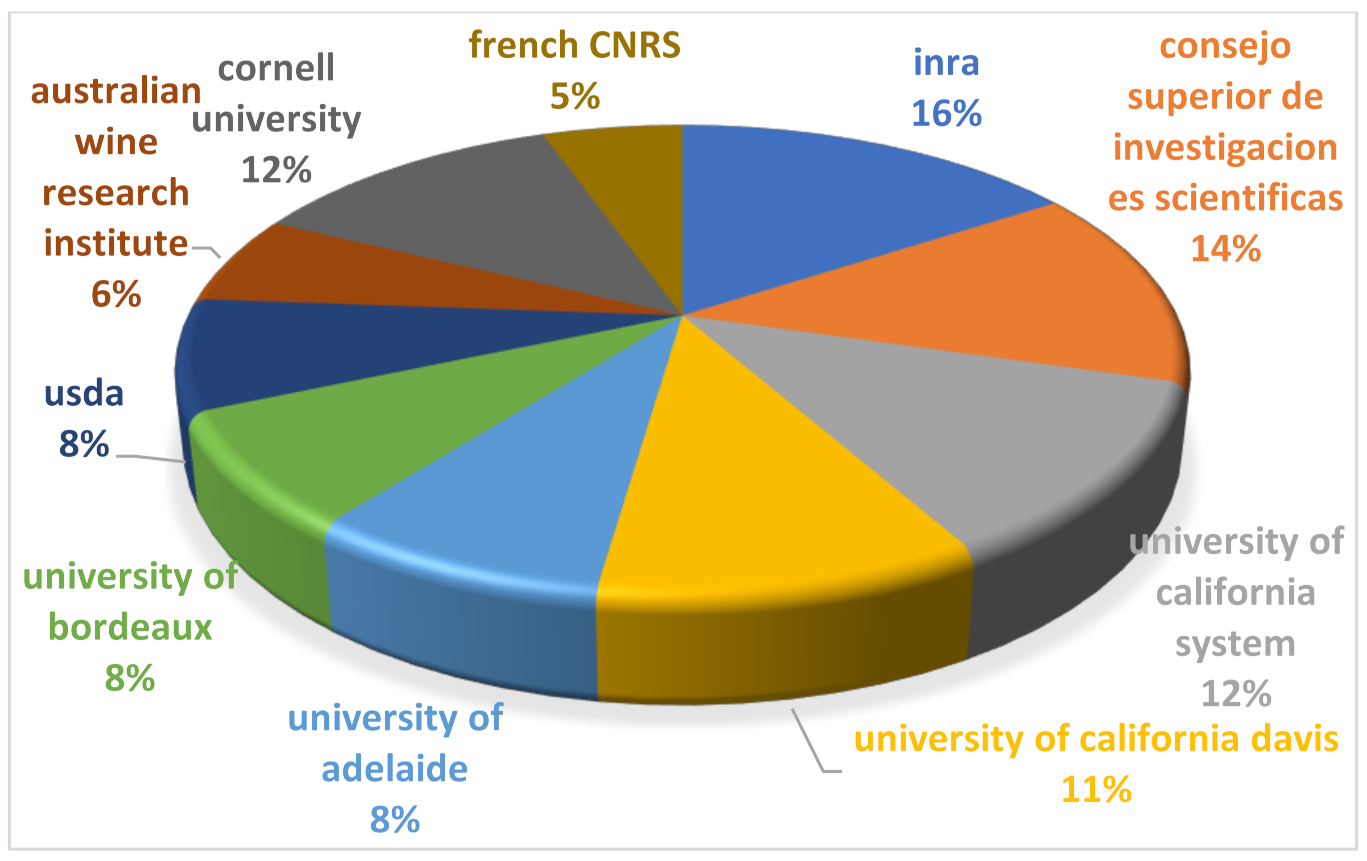1. Introduction
Fruit wines are wines made from any fruit and do not contain grapes. They are commonly known as ‘country wines.’ Fruit wines include cider, perry, plum wine, cherry wine, and wines made from various berries. Even if the production and consumption of fruit wines are not as well-known and widespread as grape wine, archaeologists agree that the first fruit wines, made from figs, dates, and watermelons, were probably made in the Mesopotamian Valley about 3500 years ago [
1]. There is, therefore, a millenary tradition of production and consumption in the history of humanity.
Nowadays, fruit wines are often produced by amateur winemakers and have commercial importance in cold climates where grapes are not grown. Cider and perry are essential products in England and northern France; increased cherry and currant wines are made in Denmark; and important American fruit wines, mainly produced on the East coast, include apple, cherry, blackberry, elderberry, and loganberry. In addition, various fruit wines are exported from the Netherlands, Denmark, Poland, Bulgaria, Hungary, Serbia, and Israel [
2]. This implies the existence of markets for fruit wines, whose characteristics, potential strengths, weaknesses, and failures are under-studied, to our knowledge.
Fruit wines are different from grape wines. They differ in taste and characteristics. In fact, fruit wines usually have a sweet taste and retain much of the flavor and color of the original fruit. Many commercial fruit wines contain about 12 percent alcohol on average. When fortified with brandy made from the same fruit, the alcohol content is about 20 percent. The alcohol content of cider and perry is usually 2–8 percent. Fruit wines differ from grape wines also concerning production technology. Making fruit wines implies processing the fruits (which involves peeling, stoning, slicing, crushing, and blending with a sugar-water solution), macerating the fruits in sugar, and fermenting. This is labor-and time intensive. In addition, fruits must have high acidity and are diluted with water and sugar before fermentation. The conversion of fruit into alcohol is a process that happens quite organically.
The economic and (possibly) empirical/econometrics analysis of fruit wines markets may help understand production and consumption patterns, improve production technology (if required), minimize production costs, and make production more efficient. Economic analysis can also help understand price formation in fruit wines markets: actual (and potential) consumers, possible market failures and distortions, and possible corrections and remedies.
To do so, it is essential to approach and analyze the fruit wines markets (also) utilizing an economic background. In this perspective, the paper has a double purpose. First, it describes the state of the arts of research, including economic research, regarding fruit wines. Second, it highlights and critically discusses the gaps that need to be addressed by economic research. The analysis of those aspects represents stimulating research and may provide important insights for strategies and policy design.
The paper is organized as follows:
Section 2 describes the state of the arts of past and current research in fruit wines;
Section 3 discusses the missing points and gaps in economic research on fruit wines;
Section 4 concludes.
2. The “State of the Art” of Current Research on the Topic of Fruit Wines
The methodology adopted for assessing the "state of the art" of current research in fruit wines is based on three steps.
The first step was purely exploratory. It aimed to present an informative overview of the existing research on fruit wines, aiming to assess what is produced in research and by which kind of institutions and experts. For this purpose, we consulted the Web of Science site and inputted several keywords, including “fruit wines”; “research on fruit wines”; “academic research on fruit wines”, and “economics of fruit wines”. While the latter has produced zero results, the other definitions often overlapped. The results of the bibliometric, exploratory exercise reported around 6435 entries.
Starting from that preliminary evidence, the second step aimed at filtering and refining the bibliometric research through several selected indicators. We have selected four indicators representing a simple and effective instrument that synthesizes and conveys key information on the past and current state-of-the-art research on fruit wines. The indicators provide a quick but complete glance of (1) the most frequent types of research outputs; (2) the most frequent scientific perspectives, approaches, and subjects; (3) the quantitative variations of research output across time; (4) the most productive institutions on the research field. This represents topics, trends, and scientific institutions.
The indicators convey information on:
- (1)
The type of research output, i.e., the scientific product (peer review articles, books, proceedings, and so on) generated by academic research in fruit wines.
- (2)
The most published research subjects in fruit wines, i.e., the most frequent scientific approaches and fields, within which the research on fruit wines is carried on;
- (3)
Evidence on trends in research output productivity in the period 1991–2021, to assess how the scientific production has evolved in time (in terms of number of scientific publications).
- (4)
The most productive academic institutions where research on fruit wine is carried out.
Figure 1 reports the frequency related to the type of scientific output. Studies on fruit wines are mostly published in research articles (78%) and review articles (9%). Conference proceedings represent 10% of the total output. The remaining production covers book chapters, books, book abstracts, working papers, and other types of research output.
Most research output (40%) is concentrated on the field of food science and technology issues. Other subjects (that more frequently inspire research on fruit wines) are chemistry applied and analytical (12% and 8% of the total research, respectively), nutritional/dietetics (10%), biotechnology and applied microbiology (8%), agricultural sciences (8%), plant science (7%), biochemistry molecular biology (5%), and agronomy (4%). From this perspective, it is interesting to highlight that Web of Science reported only 25 papers (0.38%) on the economics of fruit wines. Nonetheless, it is peculiar to stress that the research on fruit wines covers almost all fields of knowledge, even if intuitively less related to the product and the dynamics linked to the product and include, for instance, linguistics and computer sciences.
Figure 3 reports the time trends describing the research productivity from 1991 to 2021. In 1991, there were 19 research outputs (including peer review articles, books, conference proceedings, and working papers). The figure has increased exponentially in 30 years, signaling the growing academic interest for research in the subject of fruit wines.
Finally,
Figure 4 shows the top 10 institutions where research in fruit wines is carried on. It is curious to highlight that most research centers are located in countries where grape wine is produced.
The third step aimed at refining the search for selected fruit wines (like cider, perry, plum, pineapple, apricot, and different types of berries). Therefore, we have consulted the site of Web of Science and inputted several keywords for each different fruit wine, including all berry wines, cider, apple, pineapple, and apricot wines. We have found no entries for any wines but apple cider wine. A significant contribution and research activity going on in the field of apple cider wine has spurred us to proceed with a content overview of selected papers on the economics of apple cider wines. In this perspective, the work by Jensen et al. ([
3] 2021) provides a thorough survey of the existing literature on consumer preferences, demonstrating increasing interest from scholars in the field. In particular, while economic analysis on the supply side of cider wines, with some exceptions (Merwin [
4], Veteto and Nabhan [
5]) is scarce and fragmented, research focusing on consumer preferences and (actual and latent) demand have analyzed several aspects. For instance, research has focused on understanding the socio-economic variables affecting preferences for the product or the product selected characteristics. Among those socio-economic variables, finding mixed results and impacts on cider demand are:
consumer urbanization [
7,
8,
12];
consumer proximity to the farms [
15];
consumer consumption habits and familiarity with the product [
7,
8,
10,
12,
13,
16].
Concerning strictly economic variables, like product price, a study analyzed the studied prices of hard apple ciders in Quebec and found that traditional dry ciders were lower-priced per liter than effervescent hard apple ciders [
17].
3. Gaps and Challenges in Addressing Economic Research in Fruit Wines
As presented in the previous section, economic research on fruit wines (and partly on apple cider wine) seems to lack focus and analysis on most of the determinants that explain how fruit wine markets work. This is fundamental to understanding the market dynamics and to tackling market distortions and failures, if any, to improve the efficiency of the production, consumption, and exchange. According to standard neoclassical economic theory, markets are institutions where transactions among consumers and producers of goods and services occur. Market demand is the horizontal sum of each consumer’s individual demand. The market supply is the horizontal sum of each producers’ individual supply. Demand depends on consumers’ preferences, budget constraints, goods and services prices, among other variables. Supply depends on the available production technology, the price of the inputs, on the price of the final output, among other variables. Market prices convey essential information on the value that consumers and producers attached to the goods and services (or to specific qualitative characteristics of the goods and services) at the stake of the transactions. The market price can convey correct information on the value in the absence of market failure, like externalities (the most important of which, for the issue at stake, is climate change), asymmetric information, and market power [
18].
In a Walrasian equilibrium that applies to all competitive markets, output price and traded quantity are simultaneously determined by the interaction of supply and demand. The law of supply holds that price and quantity supplied are directly related to the resources used in the production process and the market conditions. Therefore, to determine the value of the fruit wines synthesized by the information conveyed by the price, both demand and supply sides have to be carefully analyzed and scrutinized.
On the demand side, it should be instructive to analyze the elasticity of fruit wine demand to price variations. What is the degree of "reactivity" of demand (or segments of demand) for different fruit wines to the variations in the price of the product? This information is essential to understand consumers’ behavior and consumption choices and to derive insights about consumers’ preferences and budget constraints in terms of the budget allocated to the consumption of fruit wines. Another critical piece of information that research should undertake is understanding the relationships among fruit wines, fruit wines, grape wines, and other alcoholic beverages. In other words, it should be very insightful to understand if fruit wines are perceived as complementary or substitutes among themselves and other alcoholic beverages. Intuitively, one can conjecture that fruit wines are considered (perfect/imperfect) substitutes among themselves and complementary with other alcoholic beverages, except consumers that present lexicographic preferences for a particular type of fruit wine. To assess such important information (fundamental to the design of market strategies), researchers should compute and estimate the crossed elasticity of demand among different products. Such information measures the variations in the demand of a good when the price of another good (that is considered a substitute or complement) varies. For instance, an exemplificative research question should be the following: if the price of cider increases, are consumers diminishing the consumer of cider and increasing the consumers of apricot wine, berries wine, or even grapes wines or beer or other alcoholic beverages? The magnitude of such an estimated phenomenon should reveal the degree of intensity of the relationship between the demand for fruit wines and other alcoholic beverages and the nature of the goods as perceived by consumers. The elasticity of demand and crossed elasticity of demand are revelatory of the dynamics underlying the product price formation (mostly linked to the consumer’s preferences for a good, its complements and substitutes, and the budget allocated to the consumption of those).
Knowledge of demand structures is fundamental to understanding how prices are determined, but it only represents half the picture. For example, two bottles of the same producer produced the same year can have different prices because their respective production processes (and related production costs) are different.
On the supply side, therefore, scholars might address points related to the price of input in the fruit wines’ input markets. Is the price for the same unit of fruit the same if that very same fruit is used for winemaking or other purposes, like jams/juices-making or row consumption? How do the variations in input prices affect the price of the fruit wines? What is the elasticity of fruit wine supply to costs variations? How is the production technology characterized? What are the production inputs that affect the costs the most? Are there both artisanal and industrial productions (like in the case of ciders in the US and Canada), and how are the different technologies of production and different scales of production affecting the supply of the fruit wines? What are the main costs affecting production? How is the cost structure of fruit wines characterized? Are costs significantly different for different fruit wines or are they similar, given similar production methods? All that information is fundamental to understanding the supply structure and, therefore, the final output price.
Another important but currently missing and understudied part of the economic analysis on fruit wines markets is the issue of market power. Market power is the capability of the firm to increase the price above the level of the marginal cost (per unit of output). When firm prices are above marginal costs, there is a reallocation of surplus from consumers to producers and an allocation of productive resources different from optimal in perfect competition, as demonstrated by the two main welfare theorems. The question to be investigated in this case should be the following: what is the degree of market power that the producers of fruit wines enjoy? An important factor affecting producers’ market power is the demand elasticity of the consumers of fruit wines to price variations. The more inelastic the demand is, the more significant the producer’s market power. However, the market power also depends on the structure of production (in particular the existence of scale economies or diseconomies) and the structure (for instance, the number of firms operating in the sector), conduct (for instance, the strategies implemented by the firms) and performance (productivity, profitability, efficiency of the sector) of the firms operating in the sector of fruit wines, among other factors.
The dynamics generated by market failure in fruit wines, like externalities, missing markets, and asymmetric information, also represent a gap in the economics of fruit wines. To our knowledge, this is understudied, and therefore it is scarcely understood if fruit wines’ markets still are niche markets concerning grape wines because of preference structures or because of asymmetric information on the product existence and characteristics, therefore missing the opportunity for demand and supply to meet and the transactions to occur.
Externalities may represent an exciting field of research. Therefore, research should investigate the existence (and the magnitude) of possible (positive and negative) externalities in the consumption and production of fruit wines. Positive (negative) externalities refer to any possible positive (negative) impacts that the consumption and production of fruit wines may have on other markets and society. For instance, the production of fruit wines might be very polluting or beneficial to other activities/sectors, thus generating social costs or social benefits, respectively.
4. Concluding Remarks
Using a bibliometric and content analysis, the short note has described the state of the art of research on fruit wines, focusing on economic research. The study has also stressed gaps that need to be addressed and filled by economics research. Results show that the fruit wines market is very understudied from an economic perspective, except for apple cider wines in North America.
The economic and (possibly) empirical/econometrics analysis of fruit wines may help understand production and consumption patterns, improve technology (if required), minimize production costs, and make production more efficient. Economic analysis and theory may support understanding price formation in fruit wines markets, the preference structure of actual (and potential) consumers, possible market failures and distortions, and possible corrections and remedies. In addition, such a “
corpus” of research should be built independently from the approaches and methods of economic analysis in grape wines markets, given that fruit wines are different products. In fact, wine has a few characteristics that differentiate it from other beverages. Wines, for example, can regularly reach very high bottle prices. Wine can be stored for a long time and can increase in value with age. Wine quality and prices are extraordinarily sensitive to fluctuations in the weather during the year in which the grapes were grown. In this perspective, studies on grape wines markets have analyzed many aspects of demand, supply, pricing mechanisms, and market failures since the seminal work of Ashenfelter (2010) [
19].
Before that, however, a whole body of research in the economics of fruit wines should be constructed. In particular, and as a critical point to the existing literature, it is crucial to scrutinize and estimate the “fundamentals” of the fruit wine markets, as discussed in
Section 3. For instance, fruit wines are experience goods whose quality cannot be ascertained before consumption. As a result, consumers often rely on “expert opinion” regarding quality.
Current economics research, on the contrary, primarily focuses on “theme variations,” looking at marginal, though necessary, factors (like socio-economic characteristics of actual or potential consumers, like age, gender, education level) that vary case by case, according to different applications. Further economic research on fruit wines economics should focus on understanding the economic “fundamentals”: consumer preferences, production technologies, price formation, and market failures, including climate change impact on production and consumption. This could help create a critical body of literature that better describes the markets for fruit wines, to improve industrial strategies and policy intervention when required. However, much work in this direction remains to be done.









